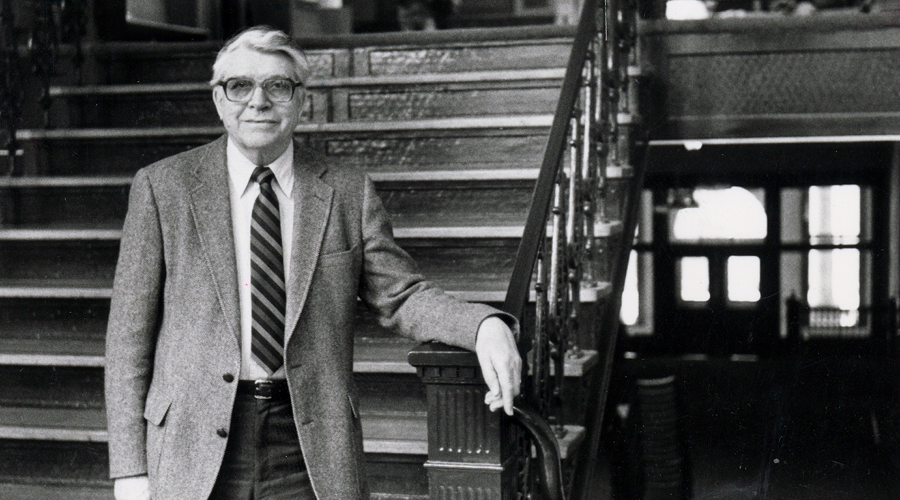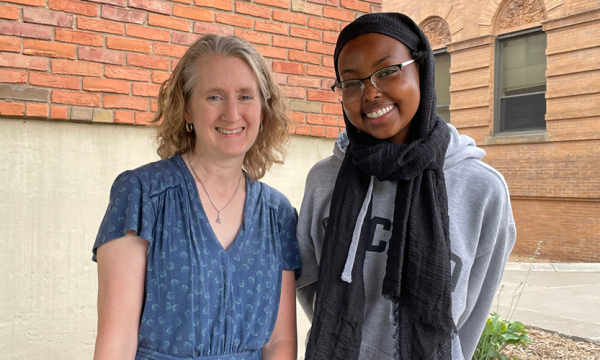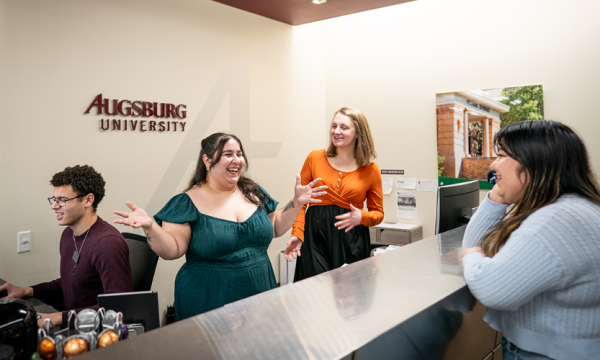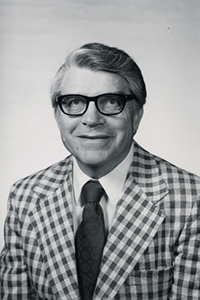
Sociology professor Joel Torstenson ’38 stood in front of the Augsburg faculty in January 1967. The kind-hearted, suit-wearing Minnesotan urged colleagues to join him in transforming the institution from a college in the city to a college of the city.
Torstenson had spent years researching and observing relationships between institutions of higher education and their surrounding communities. He critiqued institutions that isolated their campuses and intellectual endeavors from the realities of urban centers, and he was convinced Augsburg’s urban setting positioned it to engage students in addressing the complex challenges of “the modern metropolis.”
“Such a study of school and society is, of course, not a new one,” Torstenson told his colleagues that day. “The relationship between learning and living has been a matter of interest to philosophers, historians, social scientists, and educators for ages. Neither education nor society can be adequately understood without examining the interactive relationship between them. In fact, the very expansion and development of universities were in large measure a response to the rapid increase of the range of activities for which literary skills became essential in growing urban communities.”
Torstenson’s passionate address celebrated Augsburg’s growing focus on community-engaged scholarship, research, and service before concluding with 11 recommendations. The list called for departmental advisory boards of alumni and area professionals, city-campus programs, interdisciplinary field experiences, an expansion of student employment within the neighborhood, and more.
Nearly 60 years later, Augsburg University President Paul Pribbenow said Torstenson’s speech reads like a roadmap to Augsburg’s full embrace of its location as a classroom within the context of community. It was a critical turning point in Augsburg’s 150-year history, as Torstenson’s words honed Augsburg’s focus on relevant, responsive education for service.
“Professor Torstenson was instrumental as Augsburg embraced its urban setting and commitment to teaching students at the intersections of place and mission, location, and vocation,” Pribbenow said. “His radical ideas for the time set into motion programs, partnerships, and perspectives that made a lasting mark on the Twin Cities and beyond.”
Capturing that legacy
Pribbenow joined with Augsburg faculty members Katie Clark ’10 MAN, ’14 DNP and Timothy Pippert as well as former Sabo Center staff member Green Bouzard to write “Radical Roots: How One Professor Changed a University’s Legacy.” Published in November 2023, the 175-page book documents Torstenson’s legacy on the evolution of higher education for the public good and shares innovative models of experiential learning developed at Augsburg.
The authors hope these examples and lessons learned during the past 60 years bolster Auggie pride and inspire those engaged in place-based learning and service.
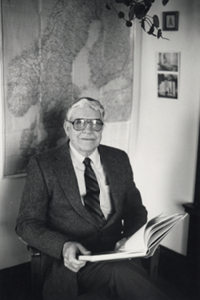
“Torstenson believed deeply in the power of returning to the roots of systems to equip individuals to shape their own destinies and the communities in which they lived,” Pribbenow wrote in the book. “His vision for education was about expanding horizons of learning and scholarship by equipping students to engage fellow citizens in the work of democracy. We think he would be proud of how Augsburg has lived out those bold ideals.”
The book begins with a look back, weaving the origins of Augsburg’s founding by Norwegian Lutherans alongside Torstenson’s formative years in rural Minnesota during the Great Depression. It chronicles his transition from teaching in a one-room schoolhouse to a fateful day during his senior year at Augsburg, when Torstenson was asked to step in as a teacher.
“(Augsburg) President George Sverdrup died unexpectedly, and Professor H.N. Hendrickson became acting president,” the book explains. “Hendrickson asked Torstenson to take over teaching his European history course, which ultimately led to Torstenson pursuing his master’s degree in history with a minor in sociology at the University of Minnesota.”
In his memoir, “Takk for Alt (Thank You for Everything): A Life Story,” Torstenson reflects on this introduction to his life’s work as a professor and academic scholar, but the academy did not command his singular focus. For nearly a decade after graduation, he and his wife, Frances “Fran” (Anderson) Torstenson, invested in community building, including an 80-acre cooperative farm they tended while he taught part-time at Augsburg.
The start of his tenure
In 1947, Augsburg recruited Torstenson to develop programs in sociology and social work, which he did while pursuing a doctorate in sociology at the University of Minnesota. Torstenson systematically expanded Augsburg’s academic programs in sociology, adding courses in sociological theory and social psychology, racial and inter-group relations, rural sociology, and social work. “He was so successful,” Pippert explained, “that for much of the 1950s, the sociology department had the most majors on campus.”
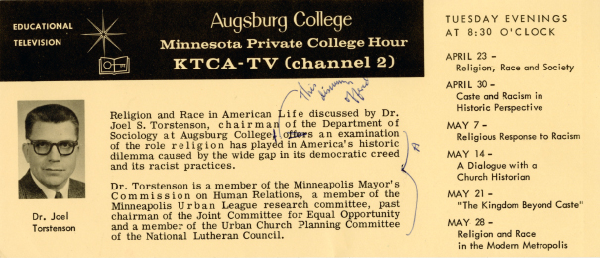
Innovative internship and cooperative learning experiences brought faculty and students into contact with urban life, but that contact remained limited to certain departments until Torstenson addressed the full faculty in 1967. Pippert said the address inspired others to embrace Augsburg’s urban context as a laboratory for liberal learning and research.
Clark said Torstenson’s humble, gentle way drew people into his sound theories. “So many people and institutions make decisions based on what is ‘trending’ or attractive to funders, but I don’t think that calculated into his decisions,” said Clark, an associate professor of nursing. “There was just no other way of doing things. You are part of your community, and when you see a need, you work to address that need. He didn’t wonder, ‘Is this scholarship or is this service?’ He just thought, ‘This is what you do as a human.’”
His vision takes root
The university began hiring faculty interested in urban issues and even encouraged faculty and staff to live and spend time in surrounding neighborhoods. Curricular innovations, including Augsburg’s interdisciplinary urban studies program and River Semester, have origins in Torstenson’s influence.
“One of the greatest lessons I learned while writing this book is how easily our trajectory could have been different had Joel not spoken up the way he did about what needed to happen, and had our faculty and staff not been receptive to this work,” said Clark, who also serves as executive director of Augsburg’s Health Commons. “I’ve always been proud of where I went to school and work, but learning our history really made me proud of how we have stayed focused on our mission through good times and bad. It’s not just what we do, it’s who we are.”
One of the boldest attempts Torstenson proposed to connect with the community and educate students about challenges facing their neighbors was the establishment of the “Crisis Colony” (a label that would not be chosen today, as the book’s authors note). This started as an intensive summer program for students from across the nation to live on the north side of Minneapolis, first in public housing and later in a former synagogue. Torstenson co-led the program with Joe Bash, a Lutheran pastor who served on the north side of Minneapolis. Sociology Professor Gordon Nelson joined them to evolve the experience into a semester program that challenged students to learn and work alongside residents.
This program became the Metro Urban Studies Term, which was the first academic program of the Higher Education Consortium for Urban Affairs (HECUA), one of the premier interdisciplinary experiential education programs in the nation. Torstenson served as the consortium’s first director and continued its expansion with the Scandinavian Urban Studies Term at the University of Oslo in 1973.
“Professor Torstenson remained ever focused on co-learning, based on the understanding that students were also responsible for creating knowledge, which was recognized as possible at the graduate level but was viewed, at the time, as too difficult at the undergraduate level,” said Pippert, who is Augsburg’s Joel S. Torstenson Endowed Professor of Sociology. “He was also innovative at the time for inviting community members to serve as experts, and they were often paid as visiting professors.”
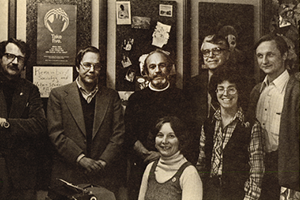
Passing the baton
In 1977, Torstenson reached Augsburg’s mandatory retirement age (of 65) at the time, but the rule allowed him to seek and mentor a successor. Through a national search, Garry Hesser was named head of the sociology department. The two worked side-by-side during Torstenson’s last year before Hesser became the inaugural Martin Olav Sabo Professor of Citizenship and Democracy.
“Joel and the faculty had set the table, and I have been feasting at that table ever since,” Hesser said in a 2015 oral history housed in Augsburg’s university archives. “A whole curriculum emerged from Joel’s paper, ‘The Liberal Arts College in the Modern Metropolis,’ which he shared with the faculty, who then voted to allow every student to take up to four internships. It took the University of Minnesota another 15 years to even grant credit for internships. And this wasn’t just urban studies, it was chemistry and religion; every major at Augsburg embraced this approach.”
Pippert said Hesser was “a giant in his own right” who mentored many faculty embedded in the city and put Torstenson’s theories into practice. “Garry took Joel’s impressive work and turned the national spotlight on Augsburg. He helped put us on the map with the policies and programs he championed for the good of our students and our city,” said Pippert, who developed Augsburg Family Scholars, a program to support students with foster care backgrounds, partially inspired by Torstenson and Hesser’s work.
Hesser assumed leadership of HECUA and became president of the National Society for Internships and Experiential Education, which elevated Augsburg to lead the national conversation about experiential education and community-based learning.
One of Hesser’s most significant efforts was leading the formation of the Center for Service, Work, and Learning in the 1990s, which became the Strommen Center for Meaningful Work and inspired the Sabo Center for Democracy and Citizenship. The Sabo Center deepened and diversified Augsburg’s commitment to and presence in greater Minneapolis, especially in the nearby Cedar-Riverside neighborhood.
Through the Sabo Center, Augsburg launched Campus Kitchen in 2003. Surplus, unserved food from dining halls is incorporated into weekly meals that students, faculty, and staff share with area residents. Campus Kitchen also supports a campus food shelf, community garden, and four community meal locations.
Clark hopes these and other examples described in “Radical Roots” encourage readers to consider the legacies on which they are building. Discussion questions at the end of each chapter prompt introspection and visioning.
“We want to make the book useful as readers pause and think about their own locations and what those places value,” Clark said. “I also hope the book reminds people to value the voices of their community and to draw on the wisdom of community members.”
Clark keeps these lessons in mind through her work at Augsburg’s Health Commons, which are nurse-led drop-in centers that welcome people without condition to a shared space that offers health services and human connection at four sites in the Twin Cities.
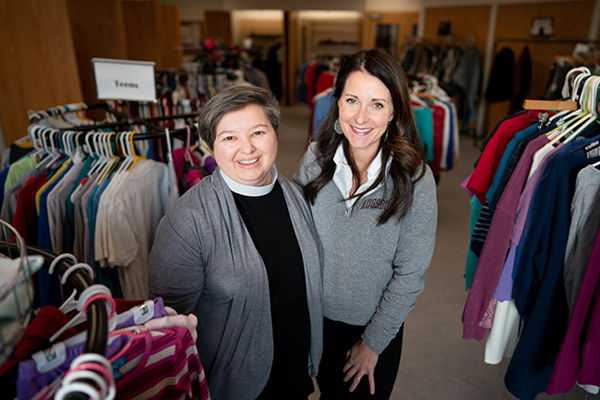
Augsburg shows up
Clark has guided the accessible, affirming Health Commons sites since she began teaching at Augsburg in 2009, more than 15 years after the first Health Commons opened at Central Lutheran Church on 12th Street in Minneapolis. These sites carry on Torstenson’s vision for place-based, embedded learning alongside community partners like Melissa Pohlman ’00, who serves as Central Lutheran’s pastor for community ministries.
For the past 10 years, Pohlman has walked with many of her neighbors to visit the commons for basic health care services, meals, and connection. It’s a vital space to combat otherness in health care, she said, and it serves as an enduring reminder of Augsburg’s drive to apply its expertise and energy to address pressing needs.
“I love the story of how the Health Commons started, with one professor in the congregation seeing a need and showing up to offer blood pressure checks and warm clothes for kids in Sunday School,” she said. “Look at what that gesture has turned into, this regular showing up that provides our community with access to dignified health care and support.”
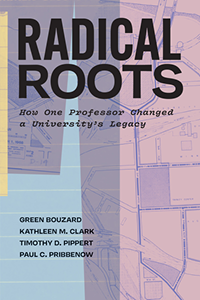
Clark said she hopes stories of impact shared in the “Radical Roots” book inspire alumni and friends to invest in Augsburg’s “radical” work to create change: “Our work isn’t easy, and it doesn’t always bring in big grant dollars, but it’s important and makes a difference, and—like Joel believed—it’s just what you do for your neighbors, your city. It’s a way of learning, working, and living that we need to continue to pass on to future generations.”
University Archivist Stewart Van Cleve, who helped the authors gather resources and create a “Radical Roots” webpage, said he hopes the book is a reminder that everyone can make a difference, but “only if we listen to one another and act as servants to the collective greatness of the community.”
“I tend to shy away from putting anyone on a pedestal, but this work makes clear that Dr. Torstenson shifted Augsburg’s trajectory to the more inclusive and neighborhood-focused institution it is today. Quite simply, we would have been a lesser institution without him,” Van Cleve said. “Torstenson realized a greatness that he could not have achieved alone. His story should make clear that we all can have that kind of impact at this university, and that is why we are here.”
Learn more about “Radical Roots” and Augsburg’s experiential learning initiatives at augsburg.edu/radicalroots.
Top image: Joel Torstenson ’38 inside Old Main (Archive photo)


